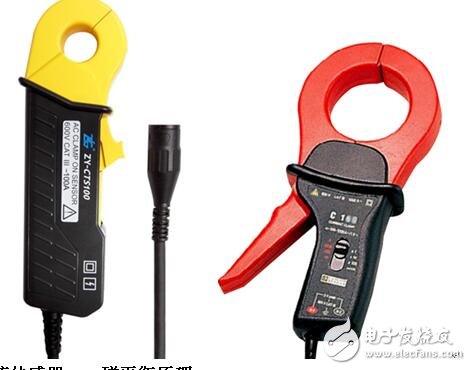Read the current sensor classification
There are so many current sensors on the market that everyone has heard or used, but do you really understand current sensors?
The current sensor converts a large current into a small current of the same frequency in phase to facilitate measurement or isolation. According to different transformation principles, current sensors generally have five technologies: Hall effect, fluxgate, electromagnetic induction, Rogowski coil (electromagnetic induction principle and ampere loop law), and shunt (ohm theorem). This article only discusses the mainstream sensors, Hall effect and fluxgate sensors.
A current clamp based on the Hall effect processes an air gap in the core to place the Hall element. The Hall element is used to measure the magnetic induction in the air gap. There are two types of open loop and closed loop depending on the control method. Both open-loop and closed-loop Hall-type current clamps measure both DC and AC.
Open-loop Hall-type current sensor - direct measurement
   The open-loop Hall type uses a Hall element with better linearity, and the output voltage of the Hall element is proportional to the current to be measured. Open-loop Hall-type transformers include the CTS series from Zhiyuan and the C117 from CA in France.

Closed-loop Hall-type current sensor - magnetic balance principle
The closed-loop Hall type uses zero-flux technology with a compensation coil on the core. When the primary current has a measured magnetic flux in the iron core, the Hall element detects the magnetic induction intensity in the iron core, and converts the error voltage into a current-driven compensation coil through negative feedback, canceling the magnetic flux in the iron core, and finally being The current measured is opposite to the magnitude of the magnetic flux generated by the compensation coil. By measuring the current of the compensation coil, the measured current can be converted according to the turns ratio.
The closed-loop Hall has less dependence on the linearity of the Hall element, and the core operates under zero flux, so the accuracy is higher than that of the open loop. The Hall element needs to provide the operating voltage, so both current clamps must be powered, and the closed-loop Hall needs to drive the compensation coil to consume more power. The closed-loop Hall sensor has Lyme's LF series current sensor.

The difference between open-loop Hall type and closed-loop Hall type current sensor
Bandwidth difference: Microscopically, the magnetic field at the air gap always changes around zero flux. Because the magnetic field changes very little and the frequency of change is very fast, the closed-loop current sensor has a very fast response time. In practice, the bandwidth of the closed-loop Hall sensor is as high as about 100kHZ, and the bandwidth of the open-loop type is below 10kHZ. The bandwidth of the closed-loop Hall sensor is higher than that of the open-loop Hall sensor.
Accuracy difference: the output of the traditional open-loop Hall sensor secondary side and the magnetic induction strong magnetic material at the core, nonlinearity and hysteresis effect are the inherent characteristics of all high-magnetic materials, therefore, open-loop Huo The current sensor generally has poor linearity, and the primary side signal has different secondary output during the ascending and descending process, which results in the accuracy of the conventional open-loop Hall sensor being lower than that of the closed-loop Hall sensor. With the development of technology, the accuracy of the open-loop Hall sensor has been able to achieve the accuracy of the closed-loop Hall sensor. For example, the accuracy of the CTS series current clamp of Zhiyuan Electronics reaches 0.3%.
Current sensor for fluxgate technology
Current sensors using fluxgate technology have an accuracy of better than 0.05% or even 12 ppm, but this type of sensor is very expensive and fragile. In the event that the sensor is not powered during use, the current being measured will cause damage to the sensor. For example, Lyme's IT-based current sensor has an accuracy of 0.05%.

Thermal Relay is used to protect AC three-phase asynchronous motor/electric motor against overload and open phase. Korlen electrical appliances produce thermal relay switch in wholesale,being a good thermal overload relay suppliers from china. We also offers Manual Motor Startor , AC Contactor, led light, Circuit Breaker etc.
Thermal Relay,Latching Relay,Reed Relay,Polarized Relay
Wenzhou Korlen Electric Appliances Co., Ltd. , https://www.zjmannualmotorstarter.com